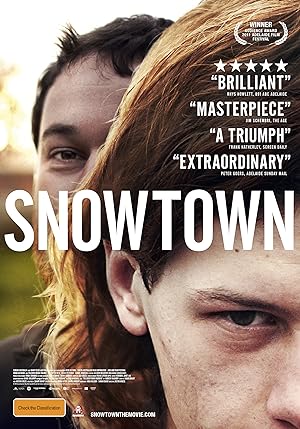I wish that I saw The Snowtown Murders when it was in the theaters. I saw Animal Kingdom in theaters, and it helped to feel like the characters: trapped, surrounded, confused and in the dark. Both films are set in Australia, based on real life, notorious, horrific crimes and set an unblinkingly bleak picture that you won’t find in tourist brochures. At home, it is impossible to give your complete attention.
The Snowtown Murders has a realistic, dingy style. Nothing is spelled out so watching events unfold can befuddle a viewer as to how significant certain moments are until the end. Characters appear and disappear suddenly so it is hard to determine if it is a part of the normal routine or sinister. The film primarily focuses on a teenage boy who becomes the target of those who like to groom and exploit him. Each subsequent abuser is worse than the first. The last one seems like a man trying to teach him how to fight and harnesses the righteous rage of his neighbors who feel neglected by law enforcement. So they take matters in their own hands, but suddenly the category of who is bad and needs to be stopped alarmingly expands to include those who cheered vigilante justice. Ultimately the pretense of revenge is completely abandoned and transforms into a community cleansing of those not deemed a useful part of society or potentially harmful: homosexuals, drug addicts, mentally disabled. Finally they just start killing people who are gainfully employed and have more than they do.
The Snowtown Murders punctures the fantasy of vigilantism and reveals a slippery slope—that there is no such thing as a person who deserves to be killed or a perfect bad guy. The perfect bad guy is your enemy, your friend, your neighbor, your lover and your family. There are signs of escalating danger if you are paying attention: the way that they treat animals, the dehumanization of people that you are supposed to be hosting and the fragility and shifting definition of male gender norms. The film also shows that while sexual abuse is unimaginably wounding, one must acknowledge the gravity of psychological abuse and how it strips the victim of his or her identity.
The Snowtown Murders is the opposite of the ringleader. Instead of seeing everyone as deserving of death and writing them off as anything but evil, the film blurs the line to show that human beings don’t always fall in neat and tidy boxes. If anyone could be a murderer one day and a victim the next, the film elicits empathy from the viewer that but for the grace of God, you could be one or the other. The lesson may not stick, but it is there. By focusing on the teenage boy, you can sympathize with his descent from victim to reluctant evildoer. One can imagine that he becomes complicit out of fear that he could easily be the next victim, or because he still thinks that it could be a just reaction.
A lot of the violence is implied, but when it is shown, it is brutal. When the teen’s mother is later resting in the same location of a murder, incidentally mourning that victim, it is chilling. The two murders that shocked me the most were not shown on screen, but strongly implied: someone who tried to help and a helpless, harmless man lost in his own litany. The occasional church scene reminded me of Ichabod, the spirit has departed the temple. By the end of the film, you realize that the poetic, landscape opening actually occurs near the end of The Snowtown Murders when the teenager crosses the invisible line.
The Snowtown Murders is a great film, but not an enjoyable one. It is a disturbing tour into small town, do it yourself genocide, but a perfect first feature film that failed to indicate the director’s future and most recent film flop, Assassin’s Creed. Hopefully Justin Kurzel’s Macbeth will strike some sort of middle ground when I watch it sometime in the near future.
Stay In The Know
Join my mailing list to get updates about recent reviews, upcoming speaking engagements, and film news.





